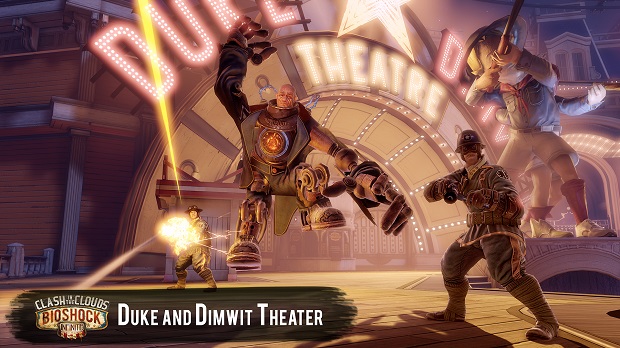BioShock Infinite: Clash in the Clouds DLC Review
When BioShock Infinite was released, complete with its own Season Pass, people started asking questions almost immediately about what the DLC would be. There’s a worrying trend in the video game industry whereby, even for primarily single-player games, the DLC included in the Season Pass only encompasses new things for the often tacked-on multiplayer portion. That couldn’t happen with BioShock Infinite though, as it contains absolutely zero multiplayer modes – so what did Irrational Games have in store for us? It was recently announced that we would be returning to pre-fall Rapture in a noir-esque series of episodic DLC called “Buried at Sea”, but, before that, we would be heading back to Columbia for a series of challenges entitled “Clash in the Clouds”.
There’s no doubt that the moment you load up the DLC and take control of Booker DeWitt, standing in front of Elizabeth once again, you feel as if you’re home among the clouds. It feels good to be back in Columbia, with everything that we loved about it the first time around – the beautifully realised world and vibrant colours, for a start – all making a welcome return, but from the moment you start playing the available challenges, you’ll be wishing that the DLC was just that little bit more substantial.
There are a few different elements to Clash in the Clouds, but the main aspect of the gameplay is centred around the four different challenge maps. Within these, the goal is to score as many points as you can and get your name as high on the leaderboard as you possibly can. There are a couple of different ways to do this: for example, you could go from the first wave all the way through to the last, just killing all of the different enemies thrown at you, or you could do something much more impressive and attempt to get all of the Blue Ribbons while you’re at it.
The Blue Ribbons are additional extras that allow you to aim for something other than simply killing the enemies. You don’t have to complete them in order to finish the level, but doing so shows up on the leaderboard, so if you care about others seeing whether or not you’ve gotten a certain amount of Blue Ribbons (and the DLC is aimed squarely at those people who do care) then you’ll to want to grab them while you can. Each challenge contains 15 waves, which get more and more difficult (as you would expect), and if you die you have to start the entire thing over again or forfeit the opportunity to upload your score to the leaderboard. This fact adds a sense of tension to the entire experience, and is something that you’ll either love or hate.

For people who want the complete BioShock Infinite experience, there’s the chance to unlock videos, concept art and more using the money you’ll earn in the challenges. There’s enough to unlock to keep even the least-competitive players interested in going back through the same challenges over and over again for a while, but there’s no denying that four challenge maps containing no story or real substance amounts to very little actual content.
VERDICT: There’s nothing wrong with having more BioShock Infinite, and even the chance to return to that world for a small amount of time is more enticing than a lot of games out there. However, it really is a small amount of time. The four challenge maps will get a little tiresome for all but the most competitive players after a couple of hours, and unless you have friends on the leaderboard that you’re trying to beat it’s a small distraction at best. The addition of the extra features, such as unlockable concept art, is initially an incentive to keep you playing, but Clash in the Clouds is too short and not as fleshed-out as it should be, and feels like little more than an appetizer for Buried at Sea. That being said, while it’s not a great appetizer, it won’t leave a sour taste in your mouth, either.

GOOD. A game that scores 7/10 is worthy of note, but unworthy of fanfare. It does many things well, but only a few of them incredibly well and, despite a handful of good qualities, fresh ideas and solid mechanics, it fails to overwhelm.




